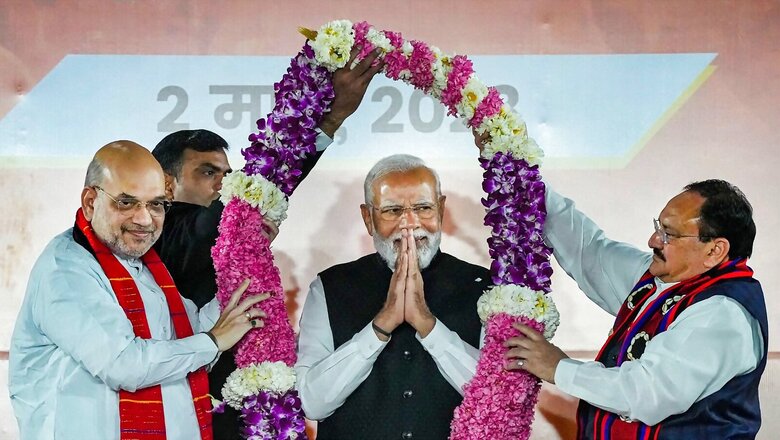
views
After the landslide victory in the 2014 elections, Prime Minister Narendra Modi was perhaps the first to spot decades of negligence towards the Northeastern states. Envisaging the states as India’s gateway to Southeast Asia, PM Modi’s ‘Look East’ policy, and now ‘Act East’ policy, has been a game-changer and a cornerstone. Juxtaposing PM Modi’s inclusive model of governance against all the previous successive governments and their dogmatic approach, it is a shame that the Northeastern states were indefinitely relegated to the sidelines by previous governments.
Early in his tenure, PM Modi had once remarked, “If the Western region of the country can develop and other regions of the country can develop, I see no reason why the Northeastern region cannot develop. It is my conviction that we have to bring this region on par with the other developed regions of the country.” And this paradigm shift has fared well for the Bharatiya Janata Party (BJP), awarding them with another electoral victory in Tripura, Nagaland, and Meghalaya.
In Tripura, the BJP’s vote share in the 2013 Assembly elections was a measly 1.36 percent, which skyrocketed to 43.56 percent in 2018. In 2023, the BJP-IPFT (Indigenous Peoples Front of Tripura) alliance returned to power, winning 33 of the state’s 60 seats. In Nagaland, the BJP and its ally, the Nationalist Democratic Progressive Party (NDPP), crossed the majority mark by winning 34 seats, 12 seats, and 22 seats, respectively. In Meghalaya, Conrad Sangma’s National People’s Party (NPP) won 26 of the state’s 60 seats and will be allies with the BJP after Sangma called up Amit Shah to seek BJP’s blessings and support in forming the next new government.
The media might well charitably assume anti-incumbency as the reason for the BJP’s consecutive victory in these states, but the party has all the more reasons to return to power. In the last eight years, the Modi administration has spent a whopping Rs 3.45 lakh crore on infrastructure in the Northeast region, equalling the cumulative spending in the past two decades.
In the last nine years, waterways, airways, and roadways have become the new symbols of the Northeastern states. The number of airports in the NE region has plummeted from nine to 16, increasing the number of flights from 900 before 2014 to around 1900. Last year, Prime Minister Modi inaugurated the Donyi Polo airport in Itanagar, which is not only Arunachal Pradesh’s but India’s first greenfield airport. The airport, built at a cost of over Rs 640 crore and spread over a region of 690 acres, is the capital city’s first airport capable of landing big planes.
Taking the waterways sector to new heights, the Modi administration has approved Rs 1 lakh crore, with the impetus to complete these projects by 2025. Besides, 19 waterways in the Northeast are being developed as national waterways.
Setting an unprecedented impetus for connectivity, the Modi government sanctioned 19 projects with a budget of Rs 77,930 crore to connect the NE region with the national rail grid. As incredulous as it sounds, even after seven decades of independence, Arunachal Pradesh and Meghalaya made their way onto India’s railway maps for the first time in 2014. In 2021, the first passenger train — the Janshatabdi Express — connecting the NE states of Manipur and Tripura via Assam, was flagged off. In another milestone last year, the first goods train chugged into Manipur’s Khongsang station, thereby enhancing Manipur’s connectivity and commerce. According to the Northeast Frontier Railways’ Chief Public Relations Officer, Sabyasachi De, between 2014 and 2022, a total of 893.82 km of track has been converted to broad gauge, 386.84 km of new lines have been added, 356.41 km of double lines have been commissioned, and a survey of 1,578 km of new lines has been completed.
To address the severe problem of road infrastructure, the Modi government rolled out a far-reaching investment of over Rs 80,000 crore under the Special Accelerated Road Development Programme in the Northeast (SARDP-NE) and an additional Rs 30,000 crore under the Bharatmala project. As per a report, in the last five years, a total of 237 projects have been undertaken, with approximately 3,099 km of road connectivity being developed across various parts of the Northeast. In 2018, PM Modi inaugurated India’s longest rail-to-road bridge — the double-decker Bogibeel bridge. The 4.94-kilometre-long bridge, built for Rs 5,900 crore, aims to play a pivotal role in the defence movement along the India-China border in Arunachal Pradesh.
Ever since the dawn of the Modi administration in 2014, militancy incidents have reduced by 74 percent, deaths of security personnel and civilians have drastically decreased by 60 percent and 84 percent, respectively, and with more than an 800 percent increase in surrenders by extremists, Armed Forces (Special Powers) Act (AFSPA) has been lifted from some districts for the first time in decades.
“It is a territory where not even a blade of grass grows, about 17,000 feet high. Ladakh is a useless, uninhabitable land. Not a blade of grass grows there. We did not even know where it was.” These were the words describing Aksai Chin, the Northeastern end of India’s crown, by the former Prime Minister Jawaharlal Nehru, that echoed off the walls of the Parliament of the world’s largest democracy. Nehru’s flub cost India 37,244 square kilometres of land. However, it takes two to tango. The verdict of the three states also reflects the efforts of the Modi administration post-2014 in bringing the Government of India to the doorstep of the Northeast region. In the past eight years, Prime Minister Modi has visited the NE region over 50 times, and around 400 Central ministers have planned strategic tours to Northeastern states.
Attempting to remove a dogmatic approach towards the Northeastern states, the Modi administration has ensured the highest-ever representation in the Union Council of Ministers, where there are two cabinet ministers and three ministers of state. Gearing up for the 2024 Lok Sabha elections, the BJP’s consecutive victory in all three states speaks volumes of the proactive shift in the approach of the Modi government and is an indictment that the Northeast was never suffering from the tyranny of distance.
Yuvraj Pokharna is an independent journalist and columnist. He tweets with @pokharnaprince. Views expressed are personal.
Read all the Latest Opinions here




















Comments
0 comment